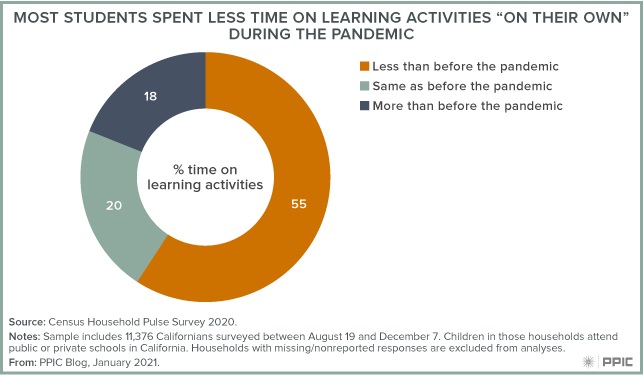
|
|

|
|
| April 25, 2024 |
|
Shortcomings of distance-learning, who is more affected? 
Despite the lifting of the statewide stay-at-home order, the vast majority of California’s public schools remain closed. Distance-learning experiences have improved since the early days of the pandemic, but we still do not know whether students are making sufficient progress and whether gaps in learning are growing among student groups.
We do know that live instructional minutes are well below the number students would have spent in classrooms before the pandemic. In fall 2020, fewer than 70 percent of students had live instruction at least four days a week, and 18 percent had no live instruction at all, the Public Policy Institute of California (PPIC) reported. However, live instructional hours are not the only way students learn: some of this decrease could be offset by additional student study hours. Yet students are spending less time on learning activities on their own than they did before the pandemic—only 38 percent now spend as much or more time on all learning activities. For some students, more study hours mean more positive engagement; for others, it means struggling with course materials and needing additional time to catch up. Alarmingly, 55 percent report spending less time now, according to an analysis of the fall US Census Bureau’s Pulse household survey. In a typical week, students spent 9.5 hours studying on their own. However, there were significant disparities along racial/ethnic and socioeconomic lines. Students in low-income families or without college-educated parents spent less time (nearly 2 hours less) than affluent peers. Similarly, African-American students spent only about 8 hours studying on their own in the prior week, significantly fewer hours than white and Asian American students spent (10 and 11 hours, respectively). The enacted 2020–21 state budget requires that most students receive about 20 hours of instruction weekly. These hours can be met through a combination of live instruction and student work. Given what we have learned from the Census Pulse Survey, it is unlikely that these instructional hours are being met. Most students are spending less time on educational activities during distance learning than before the pandemic, and these deficiencies are more widespread among low-income and less educated families, as well as African American families. (INT) Story Date: February 18, 2021
|